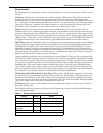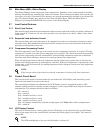
Advanced Microprocessor Controls Setup
10
Dehumidification with Normal or Delayed Reheat: Dehumidification with normal reheat allows
for operating BOTH compressors and reheats simultaneously. It is very important that electrical ser-
vice to the unit be sized and wired for this option if selected.
With delayed reheat selected, the reheats are prevented from turning on when dehumidifying with
both compressors until the point at which 100% heating is called for. At this time, the compressors
are turned off until the reheats bring the temperature back up to the point at which the reheats are
turned off.
Select Control Type
• INTELLIGENT
• PROPORTIONAL
• TUNABLE PID
The type of system control method used by the microprocessor can be selected from the front panel.
The default setting is INTELLIGENT, which approximates the actions that a human operator would
take to maintain precise, stable control. The control logic uses Artificial Intelligence techniques
including “fuzzy logic” and “expert systems” methods to maintain precise, stable control and increase
reliability by reducing component cycles. PROPORTIONAL is a standard control method that uses
one gain factor (temperature sensitivity adjustment). TUNABLE PID (Proportional, Integral, and
Derivative) uses three gain factors selected by the operator. PID allows precision tuning, but requires
an experienced operator and seasonal adjustments. Note that if PID is selected, it is used for temper-
ature control while humidity will continue to use Proportional Control. For chilled water units with
the optional Variable Speed Drive, Intelligent Control is required for proper operation.
Refer to 5.0 - Response by Control Type—Advanced Microprocessor Controls for more detail
on types of control.
Setup Alarms
Selecting SETUP ALARMS will step to the following menu:
•SET TIME DELAYS
• ENABLE ALARMS
• ENABLE COMMON ALARM
• SET CUSTOM ALARMS
Each individual alarm can be programmed with a time delay from 0 to 255 seconds. Each individual
alarm can be ENABLED or DISABLED and each individual alarm can be programmed to energize or
not to energize the Common Alarm Relay.
Set Time Delays: By programming a time delay for an alarm, the system will delay the specified
amount of time before recognizing the alarm. The alarm condition must be present for the amount of
time programmed for that alarm before it will be annunciated. If the alarm condition goes away
before the time delay has timed out, the alarm will not be recognized and the time delay timer will be
reset. For software alarms such as Loss of Power, Short Cycle, and Low Suction Pressure, a time
delay will only delay the annunciation of that alarm. The condition of the alarm is not applicable
because the condition has already occurred. For these alarms the time delay should be left at the fac-
tory default of 0. The following table shows the default time delays for each alarm.
!
CAUTION
If the electrical service to the unit is not properly sized for this option, it could trip the
building circuit breakers (or fuses) or, in extreme cases, damage the building wiring.


















